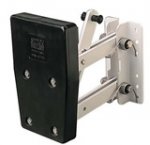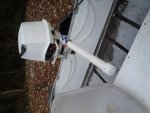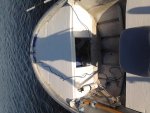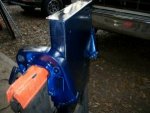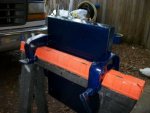Re: 1975 25 hp evinrude
Not yet! Those are good motors! And, a new motor with through hub exhaust may not solve the problem... they can be run higher on a transom, but if you look closely, there is less room between the cavitation plate and the widening of the midsection on newer motors, too. I think you have a hull issue that is easy to solve.
I was trying to remember last night what I used on a B-52 Riverhawk that I still have which had the same problem, and it was a roll of marine putty epoxy from Ace like this:
http://www.acetogo.com/product/epoxy-pc-marine-2oz.html
It comes in a roll, you break off a section, and because there are two layered parts, you roll it around in your hands like play-doh until it becomes one color. At that point, it is catalyzed and will become hard like bondo in maybe 20 or 30 minutes. IF you have a keel runner that looks like it may be drafting water up high on the leg off the bottom of the transom, roughen up the last 1/2 foot or so of the runner, mix up some of this putty, and mold it to the end of the keel to make a runner which does not rise as it meets the transom. In fact, flatten out the ending so that there is not tendency to lift water at all.
If this doesn't work or work enough, then you can add more putty to each side of your newly modified runner in a slowly sloping triangular shape (narrow toward front of boat, wide at transom) creating a delta pad. That will widen the newly cleaned up water flow off the transom while the boat is on plane.
That River Hawk had a runner which was only about an inch wide (it is actually a fiberglass boat), and the dry tube it created in the water flow off the transom was collapsing right before the leg on the outboard creating a ton of spray at 10-15 mph. Widening that slot with a delta pad about 6" wide kept that anomaly from occurring, and all the spray all went away, and without changing the motor height, I might add. (Actually, I am a motor height freak, but believe me, the older style OMC motors are much less sensitive to height, and the propellers can't handle getting close to the surface. Raising your motor 3" would probably get you 1/4 to 1/2 mph and make it tend to blow out all the time. Also, your water intake, even the main water intake behind the propeller, could be trying to suck in foamy confused water!)
2 more things... 1) That spray was happening with a 1964 Johnson 9 1/2 (old style gearcase like yours) AND a 1978 Johnson 15 (new style gear case). If there is a hull issue sucking water up on your leg, it can happen on BOTH styles of lower unit. 2) I took pictures of how the water flowed off the transom by hanging a camera (I think my cell phone actually... this was a few years back) over the back while on plane. Those pictures are what told me what was really happening and how to correct it on that boat. Just raising it on the transom would not have fixed it at all.
The total fix (minus cure time for the putty) took about 15 or 20 minutes. I have hours and hours on plane over 20 mph on that boat, and there has been no tendency for that goofy little pad to crack, separate, or do anything else bad, even though its thickness is huge relative to what you would normally use it for.





















